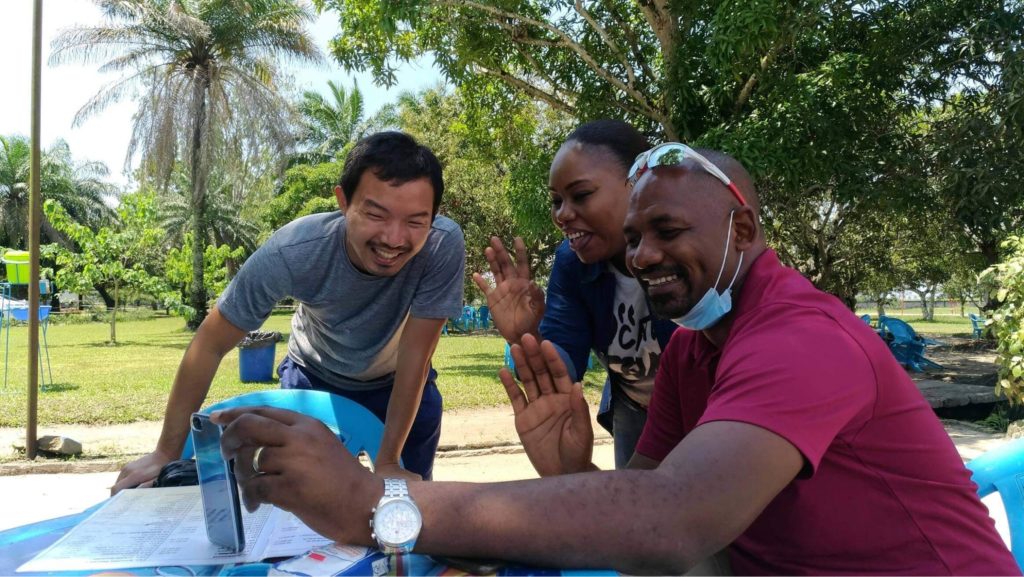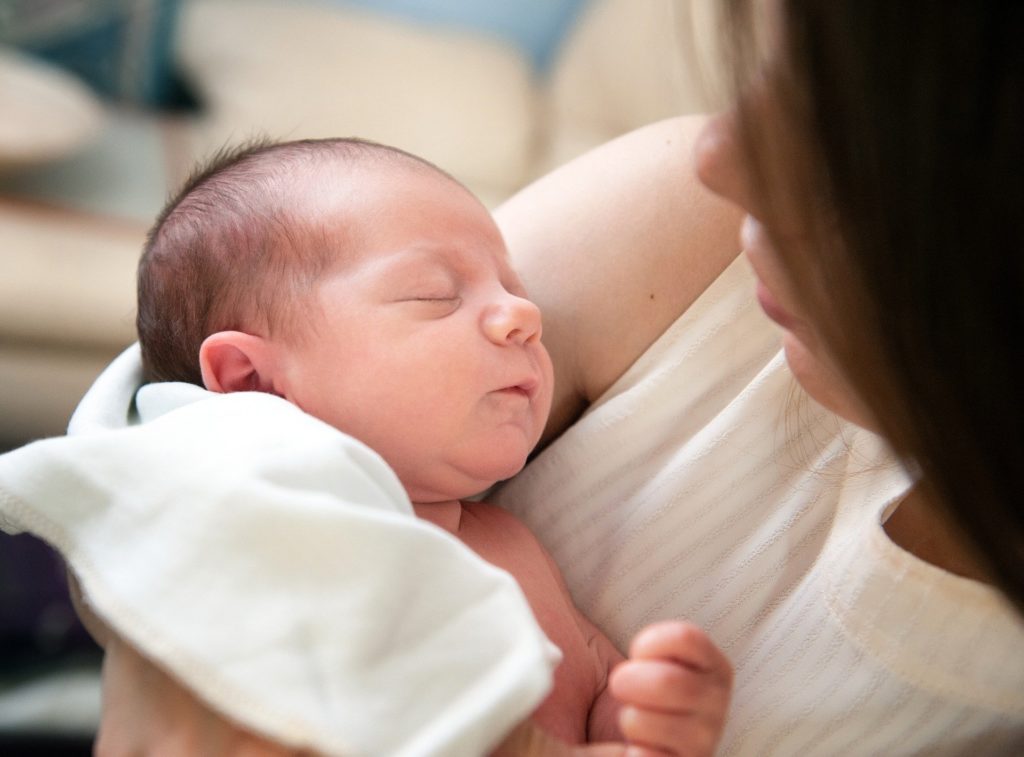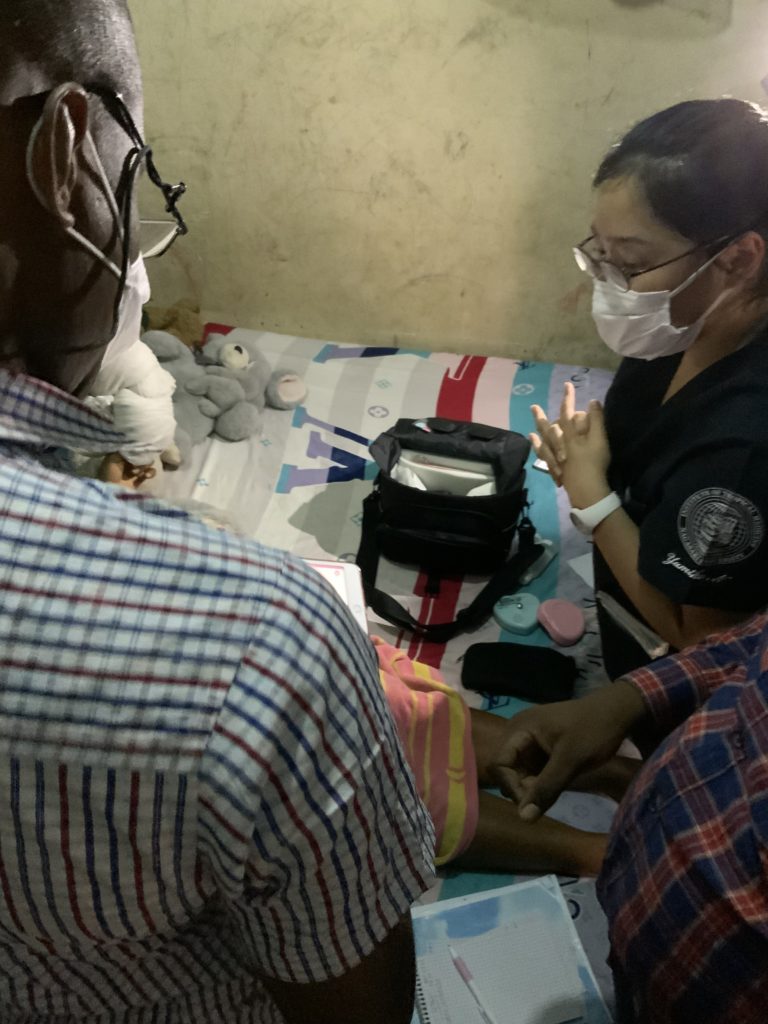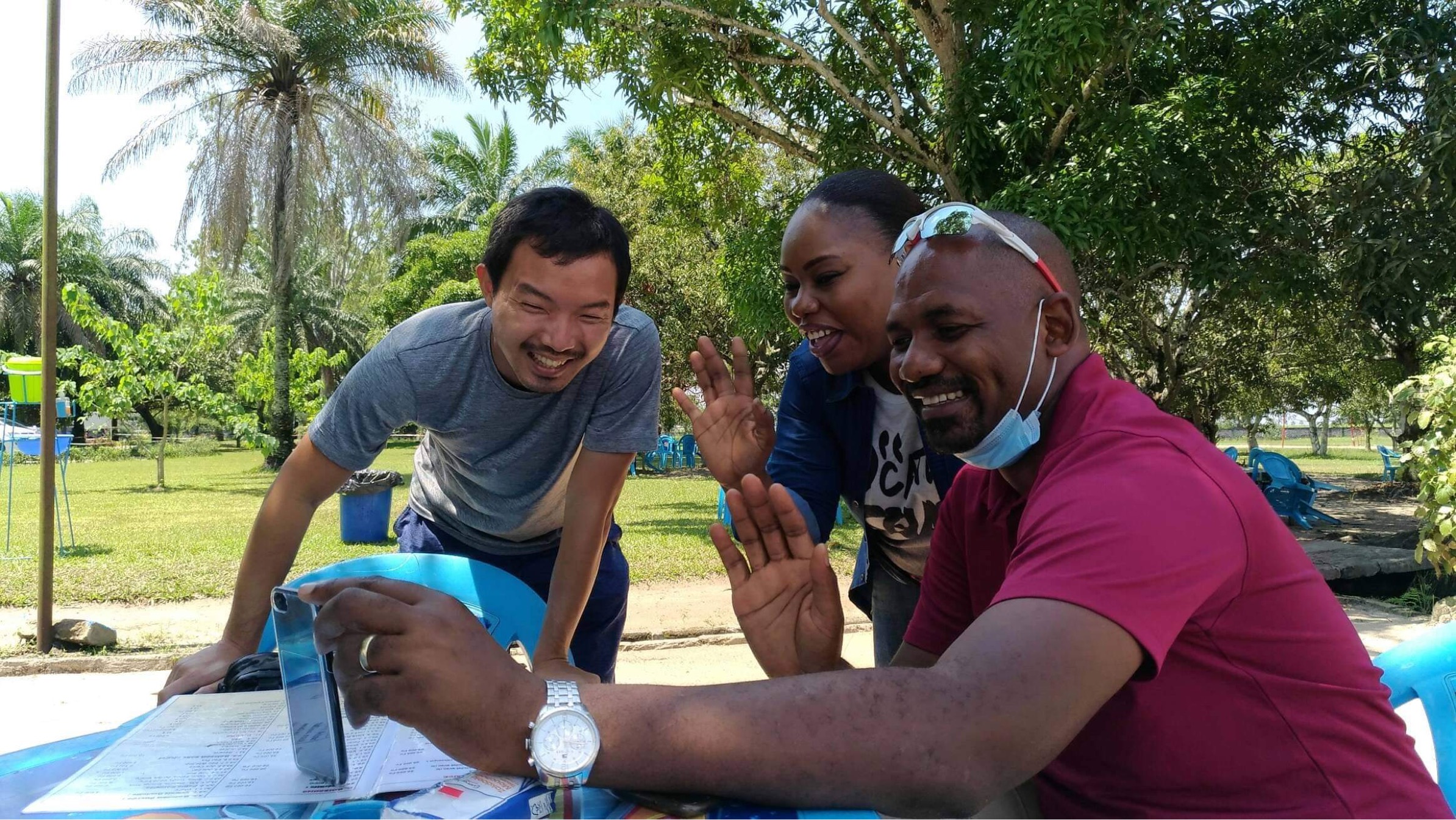Today we want to talk about what we are trying to achieve through our activities.
In December 2020, we visited Democratic Republic of Congo (DRC), and surveyed clinical resource availability and its utilization in maternal and child health facilities in collaboration with SOIK Co., Ltd., In addition to the surveys, we did a market research for portable medical equipment developed by Japanese manufactures. One of the devices introduced during our visit was a smartphone application designed to be used for antenatal services to the pregnant women.
As a part of the program, we invited health professionals from government sectors, private sectors and public associations of nurse and midwives, and held training sessions and seminars on newly developed affordable medical equipment.
After these training sessions and seminars, we had a chance to visit the Congo River just outside Kinshasa, the capital city of DRC, in a weekend during our stay. We visited a park alongside the river and enjoyed local foods and beautiful scenery.

This is a photograph taken at that time.
You can see in the photograph a Japanese gentleman and a Congolese couple, smiling and talking to a mother and baby on the smartphone.
In the picture are Mr. Furuta, the president of SOIK, Mr. Olivier, a staff member of JICA DRC office, and his wife. Mr. Furuta and Mr Olivier worked together at the JICA Congo office for long time and they have been good friends since then.
They were taking to Mr Furutas wife and their one-year-old baby on a video call connected through the internet.
They smiled and looked very very happy.
This is what we want to achieve, or our ultimate goal, through our activities.
It is about connecting mothers and babies around the world wherever you live. Mothers and babies in Japan and in DRC or other countries will become connected and get to know each other no matter where they live. And you can say “Congratulations” to each other while looking at a new-born baby on your smartphone or other digital devices from every corner of the world despite economic disparities and national borders.

Our mission, “delivering perinatal medicine and care to the world,” is only the first step to achieve our ultimate goal. Our goal is to create a world where you and I living in Japan can rejoice with mothers and her families in DRC when she gives birth to a baby and vice versa.
What we want to realize is a “world where we can share this rejoice and happiness with those living in every corner of the world”
If you use social networking services, it is not difficult to get connected with mothers and their babies living in the countries far away from your residence, the countries that you would otherwise never know.
Once these one-to-one ties or personal connections between mothers and babies throughout the world are created, they are not strangers anymore. You would care about them, worry about them and rejoice with them as if they are your family members or close friends. “That person/he/she” in Congo congratulates the birth of “my” baby in Japan. And “I” in Japan congratulates the birth of “that person’s/his/her baby” in Congo.
With the development of information and communication technology (ICT), communication costs even with friends living overseas have been substantially reduced. And you can send and receive money with digital currencies without a bank account if you have a smartphone or mobile phone and good access to the internet.
In Japan, there are many so-called ‘Foster Parents Program’ mostly advertised by international non-governmental organizations (NGOs). You can be a foster parent if you pay monthly fee to these organizations and your money will be used for the projects in the community where you foster child lives. This is a good program but you cannot assist an individual child because all the money will be used for projects benefiting all the villagers and children in the community.
Until now, these Foster Parent programs have virtually been unable to provide interpersonal assistance due to costs such as interbank transfers, even if you want to assist a particular person.
So, although it is supposed to be a ‘foster parent’ program, in reality, an organization such as an NGO pools the money in their bank accounts and uses it for projects in the entire region. The decision on where and how much money to spend is completely dependent upon the arbitrary decision of the organization that solicited donations. Is that really good?
I believe that most of the people want to help the mothers and babies they know of or have seen on the advertisement posters or the websites, not just the entire village population though we know these assistance program would be of some help for the future of the children in the areas.
But now, with just tapping on your smart phone, you can assist those children or families, who have once been hard to reach because of huge costs you have to pay for communication and other transaction costs.
There are many people in Kenya transferring money through their mobile phones. They don’t have to have bank accounts for these transactions. These digital currencies would enable us to create a platform for one-to-one donations to mothers and their families living in the remote areas in low- and middle-income countries.
However, the reality is far from it.
There are still many mothers and new born babies dying from the complications of childbirth. In order to say “Congratulations”, we first need to give these mothers and new-born babies a safe environment where decent and quality medical care will be provided to them, ensuring their survival and well-being.
To that end, we continue to think about what we need and how we can save the lives of as many mothers and babies as possible through clinical activities in developing countries.

At the same time, we are developing a platform, or smartphone application, that connects “you” in Japan with “mothers and babies” in the resource poor countries such as DRC, Sierra Leone, or any other countries.
Various types of electronic mother-child handbook applications have been developed mostly by Japanese aid agencies. But they are mostly designed to collect data on pregnant women and transfer knowledge and infomraiton regading safe maternity practice and so on. But what we are trying to develop is more than just collecting data and transferring knowledge.
Besides as a communication tool between pregnant women and midwives, we plan to add to the application a function that enables two-way communications between the one who lives in Japan and those who live in the countries in Africa, Asia or other parts of the world.
I’ve written various things, but all of them are still dreamlike stories. Developing applications and medical devices cost a lot. I applied for research funds in various ways, but I haven’t obtained them yet. The road ahead of us is a long way to go.
*******************************************************************************
Nosotros, IGPC, creemos que “debería ser el momento más feliz para todas las madres cuando llevan al bebé en sus brazos por primera vez cuando dan a luz y ese momento debe ser disfrutado por igual por todas las madres del mundo”.
Nuestra misión es “brindar a todas las madres y bebés una médica y una cura perinatal que alguna vez se consideró cuidados intensivos y que está fuera del alcance de los países pobres.”
Una de nuestras actividades es “realizar investigaciones clínicas y demostrar que la médica perinatal puede ser un medicamento asequible, independientemente de las limitaciones que enfrentan los países de ingresos bajos y medios, con avances tecnológicos y un poco de ingenio “.
Explicación del esquema de grupo en inglés
En diciembre de 2020, visitamos la República Democrática del Congo (RDC) y analizamos la disponibilidad de recursos clínicos y su utilización en los centros de salud maternoinfantil en colaboración con SOIK Co., Ltd. Además de las encuestas, hicimos una investigación de mercado para equipos médicos portátiles desarrollados por fabricantes japoneses. Uno de los dispositivos presentados durante nuestra visita fue una aplicación para smartphone diseñada para ser utilizada en los servicios prenatales de mujeres embarazadas.
Como parte del programa, invitamos a profesionales de la salud de los sectores gubernamentales, privados y asociaciones públicas de enfermeras y parteras, y realizamos sesiones de capacitación y seminarios sobre equipos médicos asequibles recientemente desarrollados.
Hoy queremos hablar de lo que estamos tratando de lograr con nuestras actividades.
Esta es una fotografía tomada cuando salimos a la orilla del río un fin de semana durante nuestra estadía en el país. Nos invitaron a unirnos a un recorrido por un parque junto al río Congo.
En la fotografía se puede ver a un japones y una pareja de congoleños, sonriendo y hablando con una madre y su bebé en el smartphone.
En la imagen están el Sr. Furuta, presidente de SOIK, el Sr. Olivier, miembro del personal de la oficina de JICA DRC, y su esposa. El Sr. Furuta y el Sr. Olivier trabajaron juntos en la oficina de JICA Congo durante mucho tiempo y han sido buenos amigos desde entonces.
Hablaban con la esposa del Sr. Fututa y su bebé de un año en una videollamada conectada a través de Internet.
Se veían muy, muy felices.
Esto es lo que queremos lograr, o nuestro objetivo final, a través de nuestras actividades.
Se trata de conectar a madres y bebés de todo el mundo dondequiera que viva. Las madres y los bebés en Japón y en la República Democrática del Congo u otros países se conectarán y se conocerán, ya sea que vivan en países ricos o en países con recursos limitados. Y puede decir “Felicitaciones” mientras mira a un bebé recién nacido de todos los rincones del mundo a pesar de las disparidades económicas y las fronteras nacionales.
Nuestra misión, “brindar medicina perinatal al mundo”, es solo el primer paso para lograr nuestro objetivo final. Nuestro objetivo es crear un mundo en el que tú y yo, que vivimos en Japón, podamos regocijarnos con alguien en la República Democrática del Congo cuando la madre dio a luz a un bebé y viceversa, porque es un milagro que un bebé nazca sin peligro.
Lo que queremos lograr es un “mundo donde podamos compartir este regocijo y felicidad con quienes viven en cada rincón del mundo”.
No es difícil conectarse con las madres y sus bebés que viven en países lejanos a su residencia, los países que de otro modo nunca conocería, si utiliza los servicios de redes sociales.
Estos lazos uno a uno o conexiones personales entre madres y bebés en todo el mundo se crearon una vez y ya no son extraños. Usted se preocuparía por ellos, se preocuparía por ellos y se regocijaría con ellos como si fueran miembros de su familia o amigos cercanos. “Esa persona / él / ella” en el Congo felicita el nacimiento de “mi” bebé en Japón. Y “yo” en Japón felicita el nacimiento del “bebé de esa persona” en el Congo.
Con el desarrollo de la tecnología de las TIC, los costos de comunicación se han reducido sustancialmente. Y puede enviar y recibir dinero con monedas digitales sin una cuenta bancaria si tiene un smartphone o teléfono móvil y un buen acceso a Internet sin incurrir en grandes costos de transacción al transferir dinero incluso al extranjero.
Hasta ahora, los programas para niños en adopción temporal prácticamente no han podido brindar asistencia interpersonal debido a costos como las transferencias interbancarias, incluso si desea ayudar a una persona en particular.
Por lo tanto, aunque es un programa de padres de crianza, en realidad, una organización como una ONG una vez junta el dinero y lo usa para proyectos en toda la región. La decisión sobre dónde y cuánto dinero gastar depende completamente de la decisión arbitraria de la organización que solicitó las donaciones. ¿Eso es realmente bueno?
La mayoría de la gente quiere ayudar a las madres y los bebés que conozco, no solo a toda la población de la aldea, aunque sabemos que este programa de asistencia sería de alguna ayuda para el futuro de los niños en las áreas.
Puede ayudar a quienes alguna vez fueron difíciles de alcanzar debido a los enormes costos que tiene que pagar por la comunicación y otras transacciones con solo tocar su teléfono inteligente y compartir la felicidad y el regocijo con esas madres y bebés.
Sin embargo, la realidad está lejos de serlo.
Todavía hay muchas madres y bebés recién nacidos que mueren a causa de las complicaciones del parto. Para decir “Felicidades”, primero debemos preparar para las madres y los recién nacidos un entorno en el que se les brinde una atención médica digna y de calidad, asegurando su supervivencia y bienestar.
Con ese fin, seguimos pensando en lo que necesitamos y en cómo podemos salvar la vida de tantas madres y bebés como sea posible mediante actividades clínicas en los países en desarrollo.
Al mismo tiempo, estamos desarrollando una plataforma que conecta a “usted” en Japón con madres y bebés en países de escasos recursos como la República Democrática del Congo, Sierra Leona, Honduras o Guatemala.
En su mayoría, las agencias de ayuda japonesas han desarrollado varios tipos de aplicaciones de manuales electrónicos maternoinfantiles, todos los cuales están diseñados solo para recopilar datos sobre mujeres embarazadas y transferir conocimientos e información sobre prácticas seguras de maternidad, etc. Pero lo que estamos tratando de desarrollar es más que simplemente recopilar datos y transferir conocimientos.
Además de como herramienta de comunicación entre mujeres embarazadas y parteras, planeamos agregar a la aplicación una función que permita la comunicación bidireccional con “yo” que vive en Japón y aquellos que viven en los países de África, Asia u otras partes del mundo.
He escrito varias cosas, pero todas siguen siendo historias de ensueño. El desarrollo de aplicaciones y dispositivos médicos cuesta mucho. Solicité fondos para la investigación de varias formas, pero aún no los he obtenido. El camino que tenemos por delante es un largo camino por recorrer.
¡Chao!



コメント